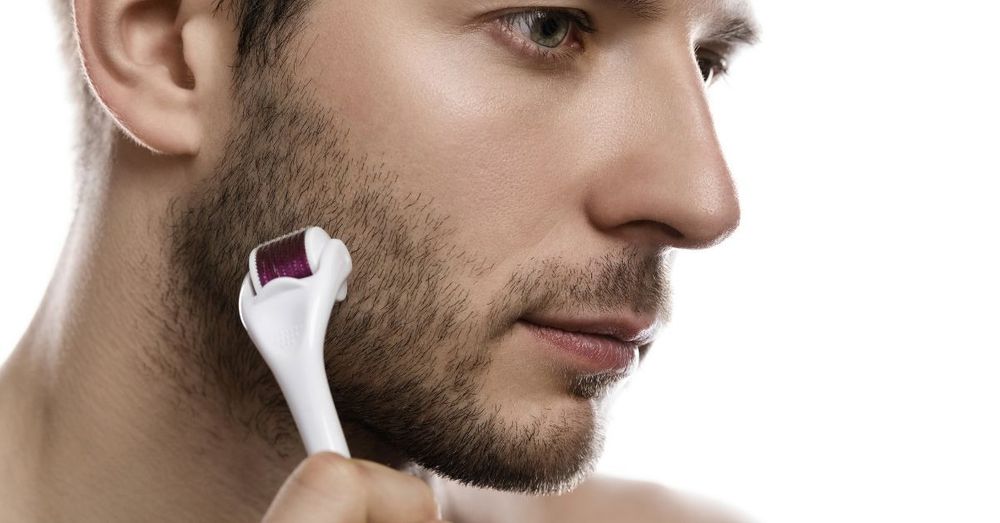If you’re wondering whether lost hair can grow back or whether hair grows back after balding, you need to read this.
The derma roller is the new trend for treating hair loss and regrowth, and there are results to back it up.
Microneedles are medical devices that must be used with caution and in a sanitary manner.
This article explains what micro needles are, how they work, and answers some frequently asked questions about them.
What is Micro Needling for Hair Loss Treatment?
Microneedling is a cosmetic treatment that addresses various ageing effects. Because of its effects on increasing collagen production in the skin, it is also known as skin needling.
Microneedling uses a skin roller with small needles to cause minor skin injuries.
Micro-needling, while commonly used as an anti-ageing skin treatment, may also be used to treat hair loss. There's even evidence that it can help with alopecia areata, a type of hair loss.
The same process that causes wounds in the skin is thought to restore the health of hair follicles. This is thought to cause new hair growth or thicken thinning hair, as seen in androgenic alopecia or male baldness.
Micro Needling for Hair Loss Benefits
Microneedling rose to prominence as a scar treatment in the 1990s. It has since been researched as an alternative or adjunctive treatment for androgenic alopecia and alopecia areata.
Aside from stimulating collagen production in the skin, which is thought to be one of the reasons it may be beneficial for acne scars, it is also thought that microneedling can help induce stem cells in hair follicles, which may lead to hair growth.
Microneedling may also promote the absorption of products used to treat your hair loss, such as:
- minoxidil (Rogaine)
- topical steroid
- platelet rich plasma
One study, in particular, looked into the potential benefits of microneedling in conjunction with a topical corticosteroid for treating alopecia areata.
Most studies look at the effects of microneedling in conjunction with another therapy, such as minoxidil, and there isn't enough research on using derma rollers alone for hair loss.
According to a 2021 review, microneedling may be more effective than minoxidil at increasing hair growth. However, the combination of minoxidil and microneedling was more effective than microneedling alone.
According to another study, some doctors may recommend using derma rollers in conjunction with minoxidil or other hair loss treatments such as platelet-rich plasma (PRP) or topical triamcinolone acetonide.
How Does It Work?
Your healthcare provider will use a roller with needles on it during microneedling.
The needles can range in length from less than 1 millimetre to a few millimetres. They're all contained within a portable device. The device, also known as a roller, is rolled along the treatment area, causing minor injuries.
Some speculate that microneedling may cause the release of growth factors or directly stimulate hair growth due to the small injury caused.
About 45 minutes before treatment, your healthcare provider will apply a topical anaesthetic to your scalp. This helps to alleviate any discomfort you may be experiencing.
The actual procedure time varies depending on the size of the treatment area, but it is usually less than 10 minutes. Following the scalp microneedling, your healthcare provider may apply a topical balm to the area or administer an injection, depending on the goal of the microneedling session.
Side Effects of Micro Needling on the Head
Microneedling itself may cause:
- bruising
- oozing from the wounds
- redness
- swelling
- pain
There's also a chance that the needle wounds will scar.
The area may be red and inflamed for a few days after the procedure. The American Academy of Dermatology (AAD) reports that most side effects subside within 5 days of treatment.
Speak with your healthcare provider before considering this treatment if you:
- have a history of acne or eczema
- have a condition that slows healing, such as diabetes
- are on blood thinners or other medications
Using minoxidil immediately after microneedling may increase absorption and cause additional burning, itching, and irritation on the scalp. It's critical to consult with your doctor about when you should resume using topical minoxidil after treatment.
Following treatment, your scalp may become more sun sensitive. It is recommended that you wear sunscreen every day. When you're out in the sun, a hat can help protect your scalp.
Another risk of having microneedling on your head is infection. Even though the needles are small, they cause wounds.
To avoid infection, carefully follow your aftercare instructions. Keeping the area clean for a few days and using a prescribed topical or oral antibiotic to ward off bacteria are common aftercare measures.
You may be more susceptible to infection if you have other serious health conditions or a history of frequent infections.
Choosing a Practitioner
Licenced skin care professionals carry out microneedling procedures. Dermatologists and cosmetic surgeons may be among them.
Because microneedling is not a surgical procedure, the risks are generally lower. However, it is still recommended that you seek the services of an experienced and trained professional to avoid complications such as scarring.
Request a consultation with each prospective provider you've identified. You will then have a better understanding of their experience as well as the estimated treatment costs.
A reputable microneedling provider will show you their work portfolio.
Doing it Yourself
In a clinical setting, dermatologists may recommend microneedling. They may, however, recommend at-home microneedling with derma rollers.
A dermaroller should only be purchased on the advice of a dermatologist or another healthcare professional.
Summing Up
Microneedling may be a promising hair loss treatment, particularly for androgenic alopecia, to add to any current treatment regimens for those who can afford it.
Discuss all of your hair growth options with your healthcare provider.
FAQs
How Often Should You Microneedle for Hair Growth?
The majority of manufacturers recommend using a dermaroller once or twice a week.
However, a dermatologist should be consulted before deciding how frequently to use a dermaroller.
Is Micro Needling Good for Scalp?
Yes, Microneedling of the scalp to promote hair growth is a procedure that is increasing in popularity and could prove particularly beneficial for those suffering from progressive types of hair loss such as androgenic alopecia (male pattern baldness), which affects both men and women.
Does Microneedling Alone Regrow Hair?
Most practitioners recommend using over-the-counter products such as Minoxidil and Finasteride to use along with Micro needlers to gain maximum benefits.
Is Microneedling Hair Permanent?
Hair growth from micro-needling may or may not be permanent depending on various factors such as genetics, lifestyle, etc.
References
R M Fertig, A C Gamret, J Cervantes, A Tosti, April 2018; Microneedling for the treatment of hair loss? - https://pubmed.ncbi.nlm.nih.gov/29194786/
Taro Koyama, Kazuhiro Kobayashi, Takanori Hama, Kasumi Murakami, Rei Ogawa, January 2016; Standardized Scalp Massage Results in Increased Hair Thickness by Inducing Stretching Forces to Dermal Papilla Cells in the Subcutaneous Tissue - https://www.ncbi.nlm.nih.gov/pmc/articles/PMC4740347/
Katrina Turrill, September 2020; Hair Loss Treatment: The Supplement Proven to Help Hair Thinning - https://www.express.co.uk/life-style/health/1286345/hair-loss-treatment-collagen-growth-vitamins-supplements https://www.ncbi.nlm.nih.gov/pmc/articles/PMC4458936/
Rachita Dhurat, June 2015; Standardized Scalp Massage Results in Increased Hair Thickness by Inducing Stretching Forces to Dermal Papilla Cells in the Subcutaneous Tissue - https://www.ncbi.nlm.nih.gov/labs/pmc/articles/PMC4458936/
Taro Koyama, January 2016; Response to Microneedling Treatment in Men with Androgenetic Alopecia Who Failed to Respond to Conventional Therapy - https://www.ncbi.nlm.nih.gov/labs/pmc/articles/PMC4740347/








